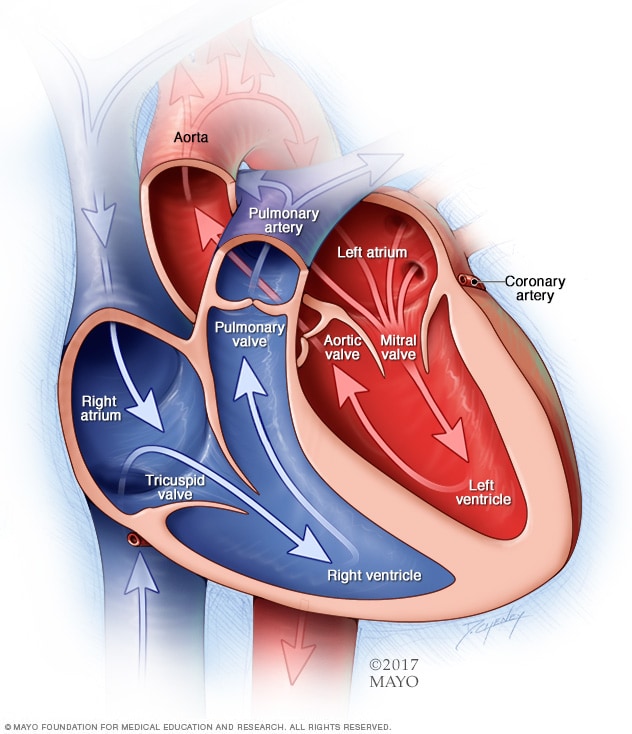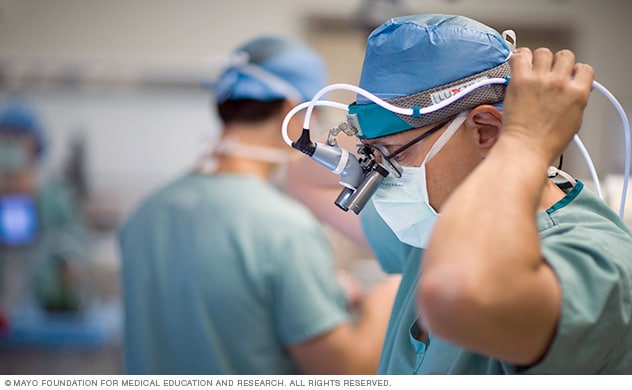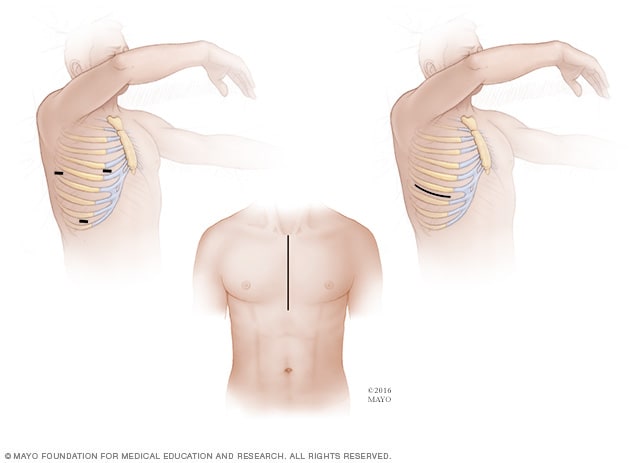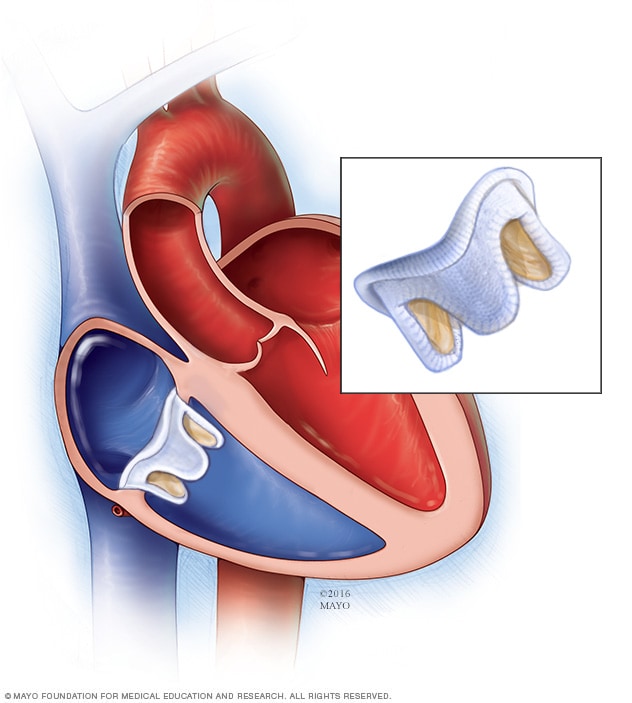Overview
Chambers and valves of the heart

Chambers and valves of the heart
A typical heart has two upper and two lower chambers. The upper chambers, the right and left atria, receive incoming blood. The lower chambers, the more muscular right and left ventricles, pump blood out of the heart. The heart valves, which keep blood flowing in the right direction, are gates at the chamber openings.
Tricuspid valve repair and tricuspid valve replacement are surgeries to treat a damaged or diseased tricuspid valve. The tricuspid valve is one of four valves that control blood flow through the heart. It separates the upper and lower right chambers of the heart (right atrium and right ventricle).
A damaged or diseased tricuspid valve can interfere with the proper direction of blood flow. The heart must work harder to send blood to the lungs and the rest of the body.
Tricuspid valve repair and tricuspid valve replacement can help improve blood flow and reduce symptoms of heart valve disease. Tricuspid valve repair or replacement may be done as open-heart surgery or as a minimally invasive heart surgery. Sometimes, tricuspid valve disease may be treated with a catheter-based procedure.
Products & Services
Types
Why it's done
Tricuspid valve repair and tricuspid valve replacement are done to fix a damaged or diseased tricuspid valve.
Some tricuspid valve conditions cannot be adequately treated with medication alone. Surgery may be needed to reduce symptoms and the risk of complications, such as heart failure.
Tricuspid valve repair or tricuspid valve replacement may be recommended if you or your child has:
- Tricuspid valve regurgitation. Blood flows backward through the tricuspid valve into the upper right heart chamber (right atrium). Many health conditions can lead to tricuspid valve regurgitation. One example is a congenital heart defect called Ebstein anomaly.
- Tricuspid valve stenosis. The tricuspid valve is narrowed or blocked. It's harder for blood to move from the upper right heart chamber (right atrium) to the lower right heart chamber (right ventricle). Tricuspid valve stenosis may occur with tricuspid regurgitation.
- Tricuspid atresia. This is a heart defect present at birth (congenital heart defect). The tricuspid valve isn't formed. Instead, there's solid tissue between the heart chambers, which restricts blood flow. As a result, the lower right heart chamber (right ventricle) isn't fully developed.
If tricuspid valve disease isn't causing symptoms, surgery may not be needed.
The type of tricuspid valve surgery needed depends on:
- The severity (stage) of tricuspid valve disease
- The symptoms
- Age and overall health
- Whether or not the condition is getting worse
- Whether surgery is needed to correct another valve or heart condition
Surgeons recommend tricuspid valve repair when possible, as it saves the heart valve and improves heart function. Having tricuspid valve repair instead of replacement may reduce the need for long-term blood thinners.
Tricuspid valve surgery may be done at the same time as other heart valve surgeries.
Leaky tricuspid valve animation
In tricuspid valve regurgitation, a leaky valve can lead to poor heart function.
The tricuspid valves job is to allow blood flowing into the heart from the body to flow to the right ventricle where it's pumped to the lungs for oxygen. If the tricuspid valve is leaky, blood can flow backwards, causing the heart to pump harder. Over time, the heart becomes enlarged and functions poorly.
Risks
All surgery involves some risk. Risks of tricuspid valve repair and tricuspid valve replacement depend on the type of procedure, your overall health and the expertise of the surgeons. If you need tricuspid valve repair or replacement, consider being treated at a medical center with a multidisciplinary team of heart surgeons and care providers trained and experienced in heart valve surgery.
Risks associated with tricuspid valve repair and tricuspid valve replacement surgery may include:
- Bleeding
- Blood clots
- Failure of a replacement valve
- Irregular heart rhythms (arrhythmias)
- Infection
- Stroke
- Death
How you prepare
Before tricuspid valve repair or replacement, you'll usually have imaging tests — such as echocardiogram — to get more information about your heart condition and the shape and function of the tricuspid valve.
Ask your care providers any questions you may have about tricuspid heart valve surgery. Discuss what to expect during and after surgery and any potential risks.
Before the day of tricuspid valve surgery, talk to your caregivers about your upcoming hospital stay. Discuss any help you may need when you return home.
Food and medications
Talk to your care providers about:
- When or if you can take your regular medications before surgery
- When or if you should stop eating or drinking the night before the surgery
Clothing and personal items
Your care providers may recommend that you bring several items to the hospital including:
- A copy of your advance directive or living will
- A list of your medications
- Eyeglasses, hearing aids or dentures
- Items that may help you relax, such as portable music players or books
- Loose-fitting, comfortable clothing
- Personal care items, such as a brush, comb, shaving equipment and toothbrush
During surgery, avoid wearing:
- Contact lenses
- Dentures
- Eyeglasses
- Jewelry
- Nail polish
What you can expect
 Tricuspid valve repair and replacement surgery at Mayo Clinic
Tricuspid valve repair and replacement surgery at Mayo Clinic
Mayo Clinic surgeons are pioneers in the field of tricuspid valve repair and tricuspid valve replacement surgery.
During the procedure
Tricuspid valve repair or replacement may be done as open-heart surgery, minimally invasive heart surgery or a catheter-based procedure.
When you arrive for surgery, a care provider will insert an IV into your forearm or hand. Fluids and medicines can be given through the IV. A care provider may shave off any hair at the location where the procedure will take place.
For most tricuspid valve repair and tricuspid valve replacement procedures, you'll receive medicines called anesthetics so you won't feel any pain. You'll be fully asleep and unconscious during the surgery (general anesthesia).
You may be connected to a heart-lung bypass machine. The machine keeps blood moving through your body during the heart valve surgery.
Tricuspid valve repair
Tricuspid valve repair is traditionally done with open-heart surgery and opening of the chest bone (sternotomy). Doctors wire the bone back together after the procedure to prevent movement and aid in healing. Sometimes, a tricuspid valve can be repaired with minimally invasive surgery.
Tricuspid valve repair surgery may involve:
- Patching holes or tears in the valve flaps
- Reconnecting valve flaps (leaflets or cusps)
- Reshaping or removing excess valve tissue so that the leaflets or cusps can close tightly
- Replacing cords that support the valve to repair the structural support
- Separating valve flaps that have fused
- Tightening or reinforcing the ring around the valve (annulus)
If tricuspid regurgitation is caused by Ebstein anomaly, heart surgeons may perform a type of valve repair called the cone procedure. During a cone procedure, the heart surgeon separates the leaflets that close off the tricuspid valve from the underlying heart muscle. The leaflets are then rotated and reattached.
Cone procedure
In the cone procedure, a surgeon separates the tricuspid valve leaflets and reshapes them so that they work properly.
During the cone procedure, the surgeon isolates the deformed leaflets of the tricuspid valve. The surgeon then reshapes them so they function properly.
Minimally invasive tricuspid valve repair
Minimally invasive tricuspid valve repair typically involves no incisions (if done as a catheter procedure) or smaller incisions and a shorter hospital stay than traditional open-heart surgery. A type of minimally invasive procedure called balloon valvuloplasty (also called balloon valvuloplasty or balloon valvotomy) is often used to treat infants and children with tricuspid valve stenosis.
During balloon valvuloplasty, a surgeon inserts a thin, hollow tube (catheter) into a blood vessel, usually in the groin, and threads it to the heart. A balloon on the tip of the catheter is inflated, which widens the narrowed tricuspid valve. The balloon is deflated and removed.
Catheter-based procedures are currently being developed to treat tricuspid valve regurgitation in some patients who aren't good candidates for surgery. A health care provider may discuss this option in special circumstances.
Tricuspid valve replacement
Incisions in minimally invasive heart surgery and open-heart surgery

Incisions in minimally invasive heart surgery and open-heart surgery
In minimally invasive heart surgery, surgeons access the heart through small cuts (incisions) in the chest, as shown in the top two images. In open-heart surgery, surgeons make a larger incision in the chest, as shown in the bottom image.
Biological tricuspid valve replacement

Biological tricuspid valve replacement
In a biological tricuspid valve replacement, a damaged or diseased tricuspid valve is replaced with one made from cow, pig or human heart tissue.
If the tricuspid valve can't be repaired, surgery may be needed to replace the valve. Tricuspid valve replacement surgery may be done as open-heart surgery or minimally invasive surgery.
During tricuspid valve replacement, a surgeon removes the damaged or diseased valve and replaces it with a mechanical valve or a valve made from cow, pig or human heart tissue (biological tissue valve).
Together, you and your care providers will discuss the risks and benefits of each type of valve and determine the one that's best for you.
If you have a mechanical valve, you'll need lifelong blood thinners to prevent blood clots. Biological tissue valves don't require lifelong blood thinners. But tissue valves can wear down over time and may need to be replaced.
If you have a biological tissue tricuspid valve that's no longer working, a minimally invasive catheter procedure may be done instead of open-heart surgery to replace the valve. The heart doctor (cardiologist) inserts a thin, hollow tube (catheter) into a vein and guides it to the tricuspid valve using X-rays as a guide. Once in place, a replacement valve is passed through the catheter into the existing biological valve. This type of tricuspid valve replacement is called a valve-in-valve procedure.
After the procedure
After tricuspid valve repair or replacement surgery, you'll generally stay in the hospital for several days. How long you stay depends on your condition and specific type of tricuspid valve surgery.
During the hospital stay, you may have:
- An IV to receive fluids and medications
- Tubes to drain urine from your bladder
- Tubes to drain fluid and blood from your heart and chest
Your care providers will:
- Check for infection at your incision sites
- Regularly check your blood pressure, breathing and heart rate
- Help you manage pain after surgery
- Ask you to take longer and longer walks to increase your activity
- Show you how to do breathing exercises as you recover
Your health care team will give you instructions to follow after tricuspid valve repair or replacement surgery. These instructions typically have details about the following:
- The medications you've been prescribed
- The warning signs and symptoms of infection
- How to care for your incisions
- How to manage pain
- Side effects of surgery
Results
How long it takes to recover from tricuspid valve repair or replacement surgery depends on the specific procedure, any complications and your overall health before the surgery.
Your care providers will tell you when you can return to daily activities, such as working, driving and exercise.
After tricuspid valve repair or replacement surgery, you'll need regular health checkups. You may have several tests to monitor your heart health and to make sure the tricuspid valve is working properly.
After tricuspid valve surgery, it's important to follow a heart-healthy lifestyle. Your health care provider may recommend these lifestyle changes:
- Getting regular exercise
- Controlling weight
- Eating a healthy diet
- Managing stress
- Not smoking
Your care provider may also suggest participating in a program of education and exercise designed to improve your health and help you recover after heart valve surgery. Such a program is called cardiac rehabilitation.
Clinical trials
Explore Mayo Clinic studies of tests and procedures to help prevent, detect, treat or manage conditions.